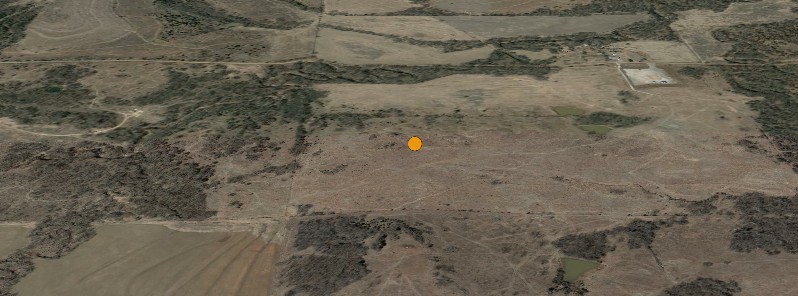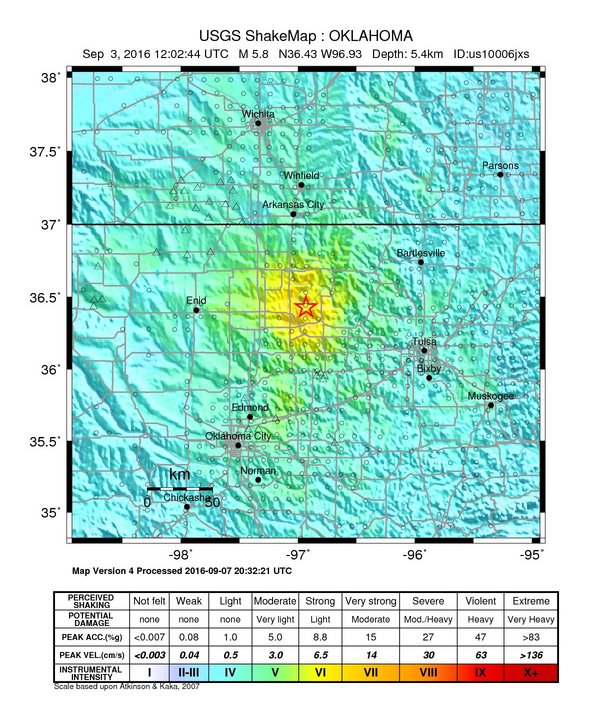USGS upgrades Pawnee earthquake to M5.8, making it Oklahoma’s largest earthquake ever

The U.S. Geological Survey has updated the official magnitude of the September 3, 2016 Pawnee, Oklahoma earthquake to Mw5.8 (from 5.6), making it Oklahoma’s largest recorded earthquake to date.
"The magnitude revision is based on further in-depth analysis of seismic recordings. Changes in estimated magnitude for an earthquake are common in the hours-to-days following the event, as more data are analyzed in greater detail than is possible in the first minutes after the earthquake occurs," the agency said in a statement on September 7.
The agency has also updated the official magnitude of the November 6, 2011 Prague, Oklahoma earthquake to Mw5.7 (from 5.6), making it the second largest earthquake to hit the state. Previously, it was considered as the largest.
Questions regarding their relative size prompted a re-analysis of both earthquakes and both updates are the result of comprehensive studies of the long-period, globally-recorded seismic data for these earthquakes, using consistent approaches and datasets for each event, USGS explained.

“USGS analyses indicate that the two earthquakes are very similar in size – to within typically-cited uncertainties of 0.1 magnitude units,” said Gavin Hayes, USGS research geophysicist. “However, the 2016 Pawnee event is slightly larger than the Prague earthquake in 2011,” noted Hayes.
“While the difference in size between the two events is less than 0.1 magnitude units,” Hayes continued, “rounding magnitudes to one decimal place means that the magnitude of the Prague earthquake is Mw5.7, and the Pawnee earthquake is Mw5.8.”
Precisely ranking the largest earthquakes in Oklahoma is difficult because seismic instrumentation has vastly improved over the last several decades. Other large, documented and felt earthquakes in Oklahoma include an instrumentally recorded 1952 event centered near El Reno, to which magnitudes of 4.9 to 5.7 have been assigned. Before the instrumental era, an 1882 earthquake in southern Oklahoma has magnitude estimates ranging from 4.8 to 5.7, based on the area over which it was felt.
Magnitude estimates can vary for a variety of reasons, including differences in methods used to compute magnitude, differences in data used, uncertainties in that data, differences in how that data is processed, and differences in our assumptions about the Earth structure through which seismic waves travel.
37 wastewater wells ordered to shut down
Saturday's earthquake has led the Oklahoma Corporate Commission to order 37 wells to shut down within seven to 10 days. "All of our actions have been based on the link that researchers have drawn between the Arbuckle disposal well operations and earthquakes in Oklahoma," spokesman Matt Skinner said. "We're trying to do this as quickly as possible, but we have to follow the recommendations of the seismologists, who tell us that everything going off at once can cause an [earthquake]."
According to Oklahoma Governor Mary Fallin, the decision to shut down the wells was a “mandatory directive” and the total area of interest is 1 877 km2 (725 mi2).
Although Oklahoma is heavily dependent on energy production, which accounts for 1 in every 4 jobs in the state, the frequency of earthquakes in the state has rapidly increased beginning in 2009. From an average of less than two 3.0+ Mw quakes per year to hundreds in 2014 and 2015, leading scientists to attribute this rise to the disposal of saltwater produced during oil extraction that has been injected more deeply into the ground. Numerous studies have confirmed the connection.
The USGS said Saturday that without studying the specifics of the wastewater injection and oil and gas production in this area, they cannot currently conclude whether or not this particular earthquake was caused by industrial-related, human activities. “However, we do know that many earthquakes in Oklahoma have been triggered by wastewater fluid injection,” the agency said in a statement.
In March 2016, the USGS published a report that said fracking was causing man-made earthquakes in parts of the United States, with northern Oklahoma at particular risk.
Last year, the state recorded 907 earthquakes, and in 2016 there have already been 400.
Researchers believe the quake activated an unknown fault
USGS Geophysicist Dan McNamara said the earthquake was not on a fault known by the USGS. Instead, it happened on a fault perpendicular which intersected the fault. Based on aftershock patterns, this one is an unknown fault that has now been activated.
"Aftershocks from that earthquake show the undiscovered fault line that runs near or through Stillwater, Oklahoma," McNamara said.
Aftershock locations show a previously unknown conjugate fault has been activated. @USGS_Oklahoma pic.twitter.com/RCIgCmAMXK
— Daniel McNamara (@DanielEMcNamara) September 3, 2016
“At this point, we don’t know if the quake is related to wastewater injection, but it’s very similar to other sequences that have been, so it’s highly likely,” said McNamara.
However, he said, this earthquake also looked natural in some ways based on the before-shock behavior. "There were only a few two to three magnitude earthquakes leading up to the big shake. This is compared to 2011 in Prague when there were three and four magnitude earthquakes before the major one."
“Magnitude fives occurred in Oklahoma maybe once every 50 to 100 years, naturally occurring earthquakes,” said McNamara. “But in the last five years, you’ve had three earthquakes over magnitude 5.”
The recently discovered fault has the potential to produce a larger earthquake, McNamara concluded.
Featured image: September 3, 2016 Pawnee, Oklahoma earthquake location. Credit: Google, USGS

Commenting rules and guidelines
We value the thoughts and opinions of our readers and welcome healthy discussions on our website. In order to maintain a respectful and positive community, we ask that all commenters follow these rules.